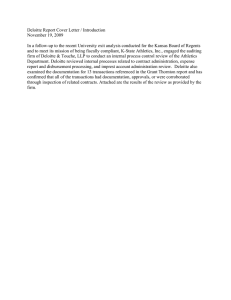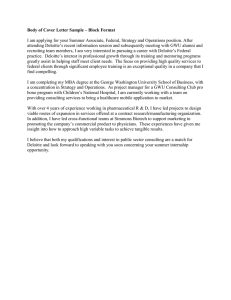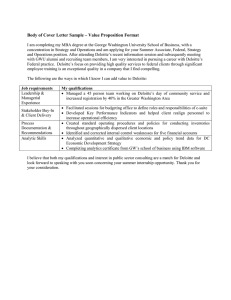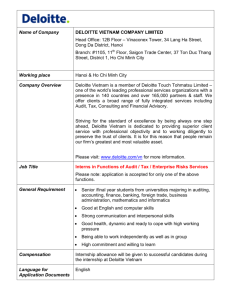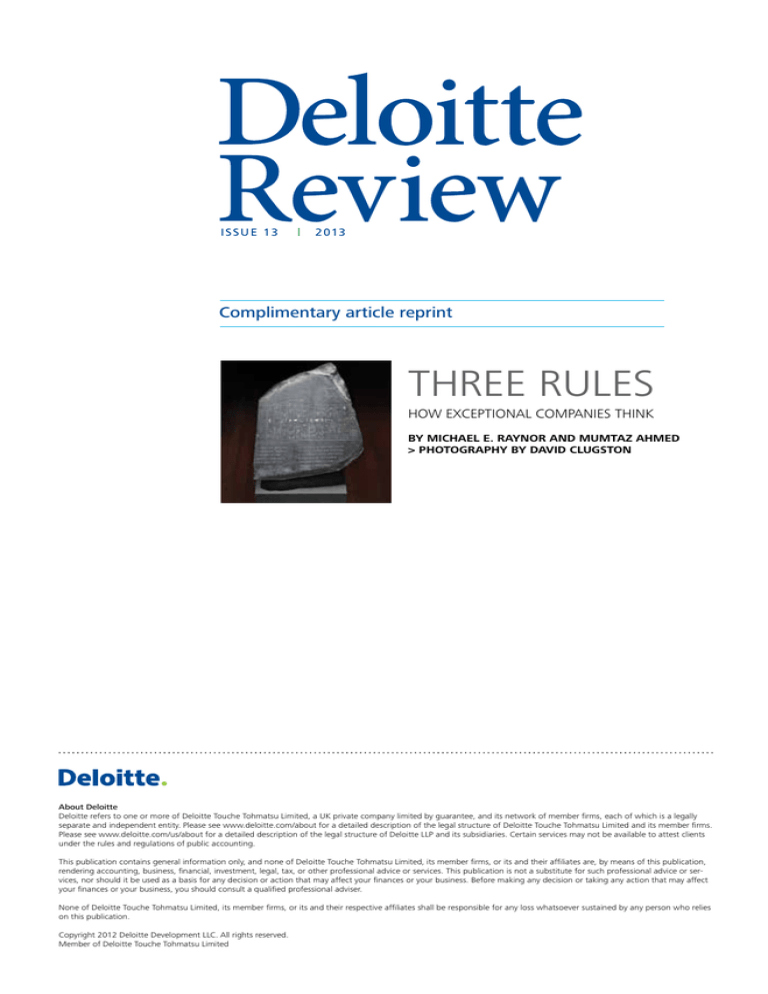
i s s u e 13
|
2 013
Complimentary article reprint
three rules
How exceptional companies think
By michael e. raynor and mumtaz ahmed
> photography by david clugston
About Deloitte
Deloitte refers to one or more of Deloitte Touche Tohmatsu Limited, a UK private company limited by guarantee, and its network of member firms, each of which is a legally
separate and independent entity. Please see www.deloitte.com/about for a detailed description of the legal structure of Deloitte Touche Tohmatsu Limited and its member firms.
Please see www.deloitte.com/us/about for a detailed description of the legal structure of Deloitte LLP and its subsidiaries. Certain services may not be available to attest clients
under the rules and regulations of public accounting.
This publication contains general information only, and none of Deloitte Touche Tohmatsu Limited, its member firms, or its and their affiliates are, by means of this publication,
rendering accounting, business, financial, investment, legal, tax, or other professional advice or services. This publication is not a substitute for such professional advice or services, nor should it be used as a basis for any decision or action that may affect your finances or your business. Before making any decision or taking any action that may affect
your finances or your business, you should consult a qualified professional adviser.
None of Deloitte Touche Tohmatsu Limited, its member firms, or its and their respective affiliates shall be responsible for any loss whatsoever sustained by any person who relies
on this publication.
Copyright 2012 Deloitte Development LLC. All rights reserved.
Member of Deloitte Touche Tohmatsu Limited
32
THREE RULES
Deloitte Review
D E L O I T T E R E V I E W. C O M
THREE RULES
THREE RULES
HOW EXCEPTIONAL COMPANIES THINK
BY MICHAEL E. RAYNOR AND MUMTAZ AHMED
> PHOTOGRAPHY BY DAVID CLUGSTON
Since 2007, Mumtaz Ahmed and Michael
Raynor, with support from colleagues from
within Deloitte * and beyond, have been working to identify what counts as “exceptional
performance” and the behaviors that cause it.
The publication of The Three Rules: How Exceptional Companies Think (www.thethreerules.com) in May 2013 is the culmination of
this years-long effort and provides an opportunity to look back and see how the journey
has unfolded in these pages as they developed
and tested their conclusions along the way.
*As used in this document, “Deloitte” means Deloitte LLP and its subsidiaries.
Please see www.deloitte.com/us/about for a detailed description of the legal
structure of Deloitte LLP and its subsidiaries.
D E L O I T T E R E V I E W. C O M
Deloitte Review
33
34
THREE RULES
“Survival of the Fattest” in January 2010 looked at the secular decline in return on assets among US public companies, observing that middling performers
were bulking up while poor performers were being punished more than ever
and top performers were doing better than ever. That observation validated the
relevance of their project: If superior performance is more difficult to achieve and
more rewarding than in the past, understanding its underlying causes is insight
worth having.
Of course, Ahmed and Raynor are not the first to tackle this problem, as they
acknowledged in “Rank Ignorance” (January 2011). Much popular business research lionizes companies that are merely salient, confusing popularity for meaningful economic performance. Statistical rigor is indispensable when separating
the skilled from the lucky and picking out truly high-performing companies.
The notion of trade-offs has featured prominently in their work. As anyone
who’s ever had Michael as a dining companion can attest, there’s no such thing as
a free lunch. “It’s a Mad, Mad, Mad, Mad World” in July 2010 explored the risk/
return trade-off in pursuit of superior performance, and “Growth’s Triple Crown,”
in July 2011 examined trade-offs among profitability, growth, and shareholder
returns.
Over the last three issues of Deloitte Review, Mumtaz and Michael shifted
gears, moving from population-level analysis to the careful excavation of specific case studies. “To Thine Own Self Be True” in January 2012 examined the
promise and peril of strategic change; “Pulling Ahead vs. Catching Up” in July
2012 looked at how individual companies made difficult choices in the pursuit
of sustained excellence, and “The Profit Parfait” in January 2013 revealed the
underlying structure of superior, long-term profitability and how to build business
models that deliver it.
The three rules they identified to describe the primary determinants of superior
long-term performance are:
1) Better before cheaper: Don’t compete on price, compete on value.
2) Revenue before cost: Don’t drive profits by cutting cost, instead find ways
to earn higher prices or higher volume.
3) There are no other rules: View all your other choices through the lens of
the first two rules.
Where to from here? The research to this point has used US-based companies
exclusively. The authors are pushing ahead to explore the frequency and nature of
exceptional performance in non-US markets and have so far completed preliminary analysis on (in alphabetical order) Australia, France, Germany, India, Japan,
Deloitte Review
D E L O I T T E R E V I E W. C O M
THREE RULES
Korea, Malaysia, Switzerland, and the United Kingdom. The questions they hope
to address are only beginning to emerge but include determining whether and in
what ways the three rules that seem so powerful in the American experience apply in other markets, or if an entirely different rulebook is required. We will publish
the first installment in the January 2014 issue of Deloitte Review.
THERE ARE NO OTHER RULES
I
t might seem somewhat precious to posit “there are no other rules” as our third
rule, but we feel it serves two important purposes. First, it is our admission that
we were unable to find any other meaningful patterns in the behaviors of our case
study companies that were associated with differences in performance. We cannot prove a negative, but in what follows we will explore at greater length why we
dismissed such perennial favorites as M&A or diversification as systematic drivers
of performance. The irretrievably idiosyncratic and contingent nature of how these
and many other behaviors contribute to performance led us to conclude that exceptional companies all have the same recipe (better before cheaper, revenue before cost)
but use different ingredients.
Second, in addition to creating superior levels of performance, exceptional
companies deliver superior levels of performance for longer than anyone has a right
to expect. It seems worth exploring, then, if and how exceptional companies adapt.
Is exceptional performance a function of deep moats and thick ramparts, or does
it require agility and flexibility to cope with competitors’ attempts to imitate
a winning formula, or with the technological, regulatory, or
other environmental changes that can render onetime advantages useless, or even turn them into liabilities?
We found that not only were there no patterns
between companies from different performance
categories, there were no patterns across
time within individual companies.
So
not only did Miracle Workers and Average Joes show no differences in
their appetites for M&A, but
individual Miracle Workers
were just as likely to adopt
M&A as to abandon it
over time. In short, what
mattered when assessing
how a behavior affected
performance was not
D E L O I T T E R E V I E W. C O M
Deloitte Review
35
36
THREE RULES
the behavior or even its implementation, but the contribution made to a company’s
adherence to or deviation from the first two rules. Where Lost It Miracle Workers
typically changed in ways that violated the rules, Found It Miracle Workers became
more aligned with the rules. Most revealing, Kept It Miracle Workers often showed
evidence of the greatest degree of change in their specific behaviors, but always in
the service of remaining in alignment with the rules. We conclude from this that
exceptional performance demands an ability to change in order to stay the same.
SAME RECIPE, DIFFERENT INGREDIENTS
W
e shared with you in chapter 1 some of the frustrations born of our search
for patterns in behavior at the level of relatively specific activities, many of
which are the subject of ongoing and extensive research and often feature prominently on managerial agendas. Take, for example, mergers and acquisitions. The
conventional wisdom has crystallized into “buyer beware,” which is certainly not
bad advice but not particularly helpful. (When would one ever think it is good not
to beware?) Research on the topic is largely consistent with this view, observing
that acquirers, on average, earn about the going rate of return on their investments
but are subject to wide variation, sometimes doing very well, sometimes spectacularly poorly.1
Unfortunately, the demonstrated riskiness of deals is not reason enough to eschew them. Mergers and acquisitions are critical to many initiatives that can be
essential to a company’s success and even its survival, from gaining access to new
technologies to international expansion to competitive preemption to creating
strategic options. Consequently, the question is not “Does M&A help?” but “Given
my circumstances, and given the details of this deal, is this particular acquisition
the best mechanism for achieving my goals as I understand them now, and how
can I employ it most effectively?” Since circumstances and goals vary widely from
company to company, and within a particular company over time, it comes as no
surprise that evidence of a first-order relationship between M&A and performance
is weak and elusive.
In our sample we saw Miracle Workers and Long Runners doing no deals (Linear and Micropac in semiconductors) and using M&A to transform themselves
(Medtronic and Stryker in medical devices), nearly driving themselves to ruin
(T&B in electrical wiring), and attempting to reverse a long-term decline (Finish
Line and Weis). The deals that worked were in accord with the rules. The ones that
didn’t, weren’t.
The relationship between business line diversification and performance is only
slightly less ambiguous, despite the recurring finding that companies with more
Deloitte Review
D E L O I T T E R E V I E W. C O M
THREE RULES
business units do worse than those with fewer.2 As with M&A and much else, an “on
average” result hides as much as it reveals. For example, consider a company that
has found a highly profitable but slow-growing niche. This company might see opportunities in an adjacent market that are less profitable than its current business,
but such diversification can still make perfect sense if those new opportunities are
profitable enough. Diversification therefore lowers the company’s performance, yet
still makes good economic sense.3
This was arguably the dilemma that faced A&F: its core business was rapidly
filling its niche in the retail landscape, yet new opportunities were not as profitable.
Part of what makes our research helpful is that it differentiates between declines in
absolute and relative profitability. Where more conventional research approaches
would see only a negative relationship between diversification and profitability in
A&F’s chosen path, we see its diversification as making a key contribution to exceptional performance by extending the run of 9th-decile results even as absolute
profitability declined.
Also running counter to expectations, we saw focus associated with mediocre
performance: International Rectifier abandoned medical devices and pharmaceuticals to concentrate its efforts on semiconductors, yet its performance only deteriorated. We therefore conclude that focus is not what matters. Better before cheaper
and revenue before cost are what matters, and it was along these fronts that IR failed
to distinguish itself.
Vertical integration is another type of diversification that has multiple determinants and wide variation in outcomes. For example, in nineteenth-century America several major manufacturing companies expanded into distribution in order to
compensate for the inadequate capabilities of the “jobber”-based channels of the
day.4 More recently, the rise of highly diversified business groups in emerging economies such as China and India has been seen as a response to all manner of “missing markets” for inputs in everything from capital to labor.5 Theoretical models
show that vertical integration can serve both nonprice and cost-based competitive
positions.6 Empirical investigations have shown in a variety of contexts that vertical
integration can be profitable or unprofitable and that changes in degree of vertical
integration in either direction can improve performance.7 In an attempt to reconcile these findings, there have been repeated efforts to define relevant contingencies that might guide us in determining when vertical integration makes sense and
when it does not.8 But here, too, there are credible competing views. For example,
some argue that vertical integration is an effective way to cope with uncertainty
while others hold that uncertainty undermines its effectiveness.9
In our sample, A&F’s vertical integration was a way to create a more responsive supply chain, which was central to its nonprice competitive position. Weis, in
D E L O I T T E R E V I E W. C O M
Deloitte Review
37
38
THREE RULES
contrast, vertically integrated in the service of its lower-cost, lower-price privatelabel strategy. Both companies enjoyed notable success, but A&F has seemed able to
renew its performance through continued commitment to the first two rules where
Weis seems less likely to recapture its past glory.
Additionally, business line diversification can sometimes be not a cause of poor
performance but instead a consequence.10 Weis did not diversify into pet supplies
until after the performance of its core grocery business had deteriorated significantly. The same can be said of Finish Line’s ill-fated expansion into hip-hop fashion
with its Man Alive franchise.
A form of diversification that seems to have a less ambiguous relationship with
performance is international expansion. Several studies have found consistent and
positive relationships, suggesting that going abroad is a good idea, and especially so
for companies with diverse product portfolios.11 Our sample seems largely consistent with these findings, for although internationalization was a drag on Hubbell’s
profitability, it seems to have helped Thomas & Betts and was central to success for
Wrigley and Merck while the lack of a global footprint seems to have been part of
Maytag’s decline.
In light of these contradictory, or at least highly nuanced, findings on these and
other dimensions of behavior, we felt it made sense to explore whether our case
study data showed evidence of any consistent patterns. Appendix J, “Behavioral
Differences by Pair-Wise Comparison,” shows the differences for all twenty-seven
pair-wise comparisons across five behaviors. Sometimes Miracle Workers do more
M&A, sometimes less, and on average there is no real difference. Sometimes Miracle Workers are more diversified, sometimes less, and on average there is no real
difference. We reached similar conclusions for Miracle Worker–Average Joe and
Long Runner–Average Joe comparisons. The absence of any compelling patterns
for these or other behaviors we were able to analyze led us to believe that anything
goes. We could find no other behaviors where the contingencies did not swamp the
prescriptions, and so the third rule is there are no other rules.
The absence of any rules beyond the first two has important implications for
how exceptional companies adapt. As with questions of position (better before
cheaper) and profitability (revenue before cost), whether exceptional companies
change over time is an empirical matter. It could have been that exceptional performance is typically achieved through relative intransigence: Find a winning formula
and stick with it. Eventually it will be overtaken by events or the competition, but
Deloitte Review
D E L O I T T E R E V I E W. C O M
THREE RULES
little matter; nothing lasts forever. On the other hand, superior performers might be
characterized by change. In this case, we would like to know if there are any guiding
principles that might help determine when and what to change.
We found that, just as the specific recipes for exceptional performance were
unique to each Miracle Worker, the nature of the changes each employed in order
to create or sustain its exceptional performance defied meaningful generalization.
There was neither a small, consistent subset of activities that responded to competitive or environmental shifts, nor did “everything” have to be reinvented. About all
that seemed to matter was the first two rules.
DEFYING GRAVITY
T
he eighteenth-century philosopher Immanuel Kant (a contemporary of David
Hume’s) formulated a “categorical imperative” that, he argued, should be the
basis of all human action: Act only according to that maxim whereby you can, at
the same time, will that it should become a universal law without contradiction.12
Lying, for example, is immoral because if everyone lied, language would cease to
have meaning and communication would become impossible—thereby making lies
impossible as well.
There is a case to be made that success studies, as a class, founder on the shoals
of Kant’s principle. Success studies seek to provide advice on how to improve your
relative performance, that is, on how to do better than the competition. This is very
different from the sort of advice that seeks to help you improve compared with your
own historical performance. A successful cost-cutting initiative will reduce your
costs compared with what they were. That says nothing, however, about how your
costs will compare with those of your competitors. If they are pursuing the same
initiative equally successfully, and so reducing their costs at the same rate you are,
you might improve compared with yourself but end up exactly where you started
compared with them. It is this phenomenon that gives rise to the Red Queen effect,
referred to in chapter 3, of having to run just to stand still.
Consequently, advice on how to compete successfully is subject to an irony that
borders on paradox. If the advice is right, then it will be universally adopted; if it is
universally adopted, it does not improve your relative performance; if it does not
improve your relative performance, it is wrong. In other words, if the advice is right,
then the advice is wrong.13
Although true, this criticism is overstated because it is based on the notion
that success studies seek the secrets of eternal dominance. Certainly this one
does not. Our objective is to make it possible to do better for longer than one
otherwise would.
D E L O I T T E R E V I E W. C O M
Deloitte Review
39
40
THREE RULES
We think of it this way. Glider pilots, like all airplane pilots, know the expression
“takeoffs are optional; landings are mandatory.” It means that no matter how high,
fast, or far you fly, you are going to come back down. Gravity always wins.
The same can be said of corporate performance. The only certainty for any company doing well is that eventually it will be doing worse. Every company that has
ever soared has or will eventually become entirely average—or worse. Although
you might not be able to predict precisely what will bring down any given high flier,
it is a sure thing that something will.
Sometimes greatness erodes because of internal failings: Inertia born of complacency might lead you to resist obvious and necessary changes; or entropy born
of hubris might dilute your focus on key customers or markets. Sometimes external
forces undermine performance: Competitors, spurred on by your success, emulate your behaviors or even improve on your original insights, leaving you with no
advantage at all; changes in customer preferences or regulatory or legislative constraints can render historical strengths irrelevant or even turn them into encumbrances. Whatever the proximate cause, just as no glider can stay aloft forever, no
company can remain on top eternally.
This unfortunate fact of corporate life imposes an upper bound on the extent of
the claims one can hope to make about the drivers of long-term, superior profitability. No advice can come with a credible promise of perpetual superiority. It might
be theoretically possible for a corporation to deliver endlessly standout profitability,
but as an empirical matter, we lack even an existence proof, never mind the sort of
sample that might make possible the inference of general principles.
We have concluded, however, that even if defeating gravity is impossible, we
can realistically hope to defy it. Despite the inevitability of a return to earth, some
glider pilots do fly higher, faster, and farther than others. Using the same equipment
in the same circumstances, some pilots—the exceptional ones—remain airborne far
longer, soar far higher, and travel far greater distances than others. For these pilots,
gliding is not a passive experience. They understand their aircraft, the conditions,
and themselves and use that understanding to find lift where others find only the
void, to achieve just the right angle of attack, or to exploit the paradox of diving
earthward to generate lift and head skyward again. Even exceptional pilots must
land—but not until long after the rest of us.
Similarly, some companies are exceptional. They are able, for a time—and occasionally for a long time—to overcome inertia, resist entropy, and adapt to competitive or environmental changes. They create better performance and sustain it
for far longer than anyone has a right to expect. Nothing lasts forever, but then, that
is not the goal. The objective is to deliver the best possible performance for as long
as possible.
Deloitte Review
D E L O I T T E R E V I E W. C O M
THREE RULES
Every glider lands eventually. But how long it stays up, how far it flies, and the
heights it reaches are all profoundly affected by the pilot’s choices. It is our belief
that by consciously adopting the three rules—better before cheaper, revenue before
cost, and there are no other rules—you can reasonably hope to deny gravity its due
for just that much longer. DR
Michael Raynor is a director with Deloitte Services LP and its Innovation theme leader. He
is the author or co-author of four books, most recently The Three Rules: How Exceptional
Companies Think (May 2013).
Mumtaz Ahmed is a principal in Deloitte Consulting LLP and the chief strategy officer of
Deloitte LLP.
Excerpted from The Three Rules: How Exceptional Companies Think. Published by Portfolio/Penguin. Copyright © Deloitte Development, LLC, 2013. www.thethreerules.com
Endnotes
1.
The most comprehensive review of the M&A literature we are familiar with is Robert F. Bruner, Applied Mergers &
Acquisitions (Hoboken, N. J.: John Wiley & Sons, Inc., 2004).
2.
The literature here is vast. Cornerstone findings include Richard P. Rumelt, “Diversification Strategy and Profitability,” Strategic Management Journal 3 (1982): 359–69; L.H.P. Lang and R. M. Stulz, “Tobin’s Q, Corporate
Diversification, and Firm Performance,” Journal of Political Economy 102(6) (1994): 1248–80; P. G. Berger and E.
Ofek, “Diversification’s Effect on Firm Value,” Journal of Financial Economics 37 (1995): 39–65. Recent investigations, however, suggest that we’ve been wasting our time and that the so‑called diversification discount is little more
than an artifact of segment-based reporting. See Xi He, “Corporate Diversification and Firm Value: Evidence from
post-1997 data,” International Review of Finance 9(4) (2009): 359–85.
3.
Cynthia A. Montgomery and Birger Wernerfelt, “Diversification, Ricardian Rents, and Tobin’s Q,” The RAND
Journal of Economics 19(4) (1988): 623–32.
4.
A. D. Chandler, The Visible Hand: The Managerial Revolution in American Business (Cambridge, Mass.: Harvard
University Press, 1997).
5.
Tarun Khanna and Krishna G. Palepu, “Is Group Affiliation Profitable in Emerging Markets? An analysis of diversified Indian business groups,” Journal of Finance 55(2) (2000): 867–91.
6.
Robert C. Schmidt, “On the Robustness of the High-Quality Advantage under Vertical Differentiation,” Journal of
Industry, Competition and Trade 6 (2006): 183–93.
7.
See, respectively, Robert D. Buzzell, “Is Vertical Integration Profitable?” Harvard Business Review (January–February 1983); Richard A. D’Aveni and D. J. Ravenscraft, “Economies of Integration Versus Bureaucracy Costs: Does
vertical integration improve performance,” Academy of Management Journal 37(8) (1994): 1167–1206; Richard
T. Mpoyi and K. E. Bullington, “Performance Implications of Changing Vertical Integration Strategies,” American
Business Review (January 2004).
8.
Kathryn Rudie Harrigan, “Matching Vertical Integration Strategies to Competitive Conditions,” Strategic Management Journal 7 (1986): 535–55.
9.
Cf. Hau L. Lee, “Aligning Supply Chain Strategies with Product Uncertainties,” California Management Review
44(3) (2002); and Srinivasan Balakrishnan and B. Wernerfelt, “Technical Change, Competition and Vertical Integration,” Strategic Management Journal 7 (1986): 347–59.
10.
J. M. Campa and S. Kedia, “Explaining the Diversification Discount,” The Journal of Finance 57 (2002): 1731–62;
Belen Villalonga, “Does Diversification Cause the ‘Diversification Discount’?” Financial Management 33(2) (2004).
11.
J. D. Daniels and J. Bracker, “Profit Performance: Do foreign operations make a difference?” Management International Review 29(1) (1987): 46–56; Michael A. Hitt, R. E. Hoskisson, and Hicheon Kim, “International Diversification: Effects on Innovation and Firm Performance in Product Diversified Firms,” Academy of Management Journal
40(4) (1997): 767–98; Stephen Tallman and L. Jaitao, “Effects of International Diversity and Product Diversity on
the Performance of Multinational Firms,” Academy of Management Journal 39(1) (1996): 179–96.
12.
Immanuel Kant, Grounding for the Metaphysics of Morals, 3rd ed. (1785), transl. James W. Ellington (Hackett, 1996), 30. As philosophical principles go, this one has had a pretty good run. As you might expect, it is not without its critics, but it has resisted any credible reformulations until only very recently; and even here the conversations are just beginning: you cannot expect a principle that has held its ground for more than two hundred years to topple over in a relative instant. See Derek Parfit, On What Matters (New York: Oxford University Press, 2011).
13. See Phil Rosenzweig, The Halo Effect (New York: Free Press, 2007).
D E L O I T T E R E V I E W. C O M
Deloitte Review
41


